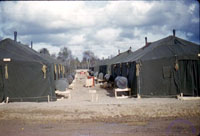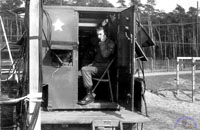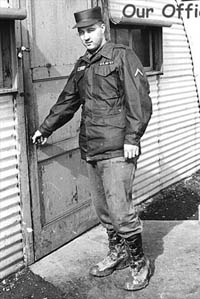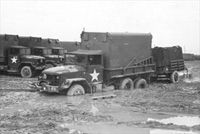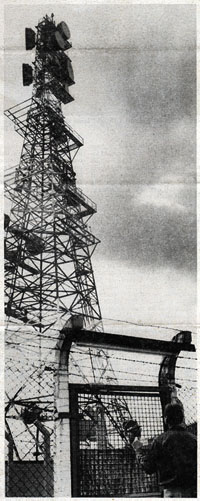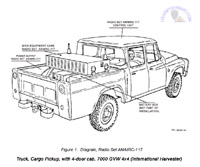| If you do
NOT see the Table of Contents frame to the left of this page, then
Click here to open 'USArmyGermany' frameset |
|||||||||||||||||||||
|
69th
Signal Battalion |
|||||||||||||||||||||
|
|
|||||||||||||||||||||
|
|||||||||||||||||||||
|
|
|||||||||||||||||||||
| Battalion History | |||||||||||||||||||||
| 1945 - present | |||||||||||||||||||||
 69th Signal
Battalion DUI
69th Signal
Battalion DUIWorld War II The 69th Signal Battalion originated at Camp McCain, Mississippi. On 13 August 1942, it was constituted and then activated on 15 December 1942, as an affiliate unit sponsored by the Ohio Bell Telephone Company. On 19 July 1944, the unit landed on Utah Beach and joined the recently activated XX Corps of LTG George S. Patton's Third US Army, as the Corps Signal Battalion. As part of XX Corps, the battalion advanced across Central Europe through France to the heart of Germany and then southward to Austria, a distance of over 750 miles in 281 days. This pace resulted in an average of one command post displacement every three days. Though often forced to fight as infantry, the battalion accomplished its mission of providing Corps Headquarters with communications support. After VE-Day, the battalion continued to serve XX Corps in its occupation role in Bavaria. The battalion returned to inactive status on 20 April 1946. France Reactivated on 11 March, 1955, the 69th Signal Battalion served under the Second Army at Fort George G. Meade, Maryland. On 23 February 1960, the battalion was reorganized under TO&E 11-95D as the 69th Signal Bn (Army) with the mission of providing signal support for a mobile field army and its semi-fixed rear command post. During the summer of 1961, the Cold War tensions suddenly increased (Berlin Wall) and the 69th Signal Bn was one of the first STRAC units alerted for overseas movement. On 24 October 1961, the battalion arrived at Cherbourg, France. (Webmaster Note: The battalion, or at least A Company, served in Orleans, France during this period, probably as an element of the 1st Signal Group, France.) The battalion returned to the United States in 1963. Germany After distinguished service in Vietnam, the 69th Signal Battalion was inactivated on 11 November 1972, and reactivated on 1 July 1974, as a part of a general reorganization and redesignation of the US Army Communications Command, Europe. The battalion was redesignated from the 68th Signal Battalion, whose colors were retired. During the following 12 months, the battalion deactivated the 256th Signal Company and the mission and all of the assets of the 256th were absorbed by the 534th Signal Company. On 1 April 1980, the battalion assumed control of USACC-Activity INSCOM, Augsburg and the two satellite terminals previously assigned to the 730 (sic) Signal Battalion. With the assumption of the new unit and terminals, the 69th activated the 267th Signal Company on 1 April 1989. The 69th Signal Battalion became the largest battalion in the 5th Signal Command. |
|||||||||||||||||||||
| 1994 | |||||||||||||||||||||
| (Source: Email from Thomas Noreen) | |||||||||||||||||||||
| I was battalion commander from June 1994 to June 1996. The headquarters was moved from Nuremberg to Wurzburg when I took command. At the time we had all of the garrison communications support in Bavaria. During that time, the facilities at Garmish, Berchesgarten, and Chiemsee were transferred to the 52d Sig Bn in Stutgart. By the end of my tour, we closed all of the facilities in Nuremberg. At that time the 3rd Inf Div HQ was in Wurzburg. During my tour it was redesigned at the 3rd Inf Div at an impressive re-flagging ceremony at the Residance in Wurzburg. Sometime in the early 2000s, the battalion was relocated to Graf where it was decommissioned. I worked with a NCO 2007 while I was working a NATO civilian on SHAPE in the J6 that had come from the battalion in Graf and remembered seeing my picture on the wall with other former commanders. To show how small the world is, my daughter was assigned to Schweinfurt in 2012 shortly before it closed. While inprocessing, one of the clerks asked her if she knew of a LTC Noreen. I knew her husband, who was a civilian at Hohenfels where I worked then. She acknowledged. I didn't know it but I'd been working with her husband in Hohenfels for a number of years where I worked as a part time contractor in support of JMRC exercises! |
|||||||||||||||||||||
| 2014 | |||||||||||||||||||||
| (Source: Email from Kyle Higgins) | |||||||||||||||||||||
| Just a heads up, the 69th Signal Battalion was deactivated in October 2014. I was among the last members of the unit. Soldiers of the 69th Rolled up under 102nd Signal Battalion, however administratively they fell under 44th Expeditionary Signal Battalion, as 44th was relocated to Grafenwoehr from Schweinfurt in late 2013/early 2014. Also inactivated in that time frame was the 7th Theater Tactical Signal Brigade and the 72nd Expeditionary Signal Battalion. |
|||||||||||||||||||||
| If you have more
information on the history or organization of the 69th Signal Battalion,
please contact me |
|||||||||||||||||||||
| Occupation Army (1945-1946) | |||||||||||||||||||||
| France (1961-1963) | |||||||||||||||||||||
| 1961 | |||||||||||||||||||||
| (Source: Email from Robert Pitts, A Co, 69th Sig Bn, 1961-62) | |||||||||||||||||||||
| In 1961 I was with A Company, 69th Sig. Bn. when the unit was shipped out of I remember returning from a weekend off base and being told to pack my bags we were shipping out. I said this can’t be, I had just returned in April from a year in We must have arrived at our base just after the engineers had completed cutting down and removing the trees from the forest and building our tent city. We lived in tents in a hole made in the forest. We rode in deuce and a half’s to the showers and chow three times a day. Everything was always covered with mud. I have attached a few photos of some of the guys, and our living quarters. |
|||||||||||||||||||||
|
|||||||||||||||||||||
|
|||||||||||||||||||||
|
|||||||||||||||||||||
|
|||||||||||||||||||||
| (Source: Email from Randall L. Smith) | |||||||||||||||||||||
I was assigned to Co A, 69th Sig Bn at Orleans, France, straight from Signal School at Fort Gordon, GA on 15 July 1962. The entire company, including Orderly Room and Messhall were in Quanset huts on concrete pads. I remember that we had telephone communications with each unit of the Battalion. I went many times to HHC at Vassincourt, France. I also went to either B or C Company, in Germany, but I don't remember the Town.
When DeGalle put US Forces out of France, the entire battalion, minus the company in Germany, rotated back to Fort Eustis, VA in Aug-Sep 1963. We drove our vehicles with windshields down to the Southern Coast of France, and loaded them aboard the USS Darby for transport to Norfork, VA. We didn't know that we were also leaving on this ship, but we did. All of the Battalion except the one company in Germany came back to the States, we were told that that company had lost its colors in WW II and had to stay in Germany for 100 Years. I took a short discharge and re-enlisted and ended up at the USASTRATCOM FAC (7300) at Fort Bragg, NC, where I got McNamara orders for Vietnam USASTRATCOM FAC (7600), Phulam, RVN. Not long afterwards, the 69th Signal BN (in its entirety) arrived at Ton Son Nhut AB, near Saigon. It was got to see my old friends again. This is all I know about its history from the standpoint of a young 17-year old, and a Pvt at that. |
|||||||||||||||||||||
| 1962 | |||||||||||||||||||||
| (Source: Email from Jim Willis, B Co, 69th Sig Bn, 1962-63) | |||||||||||||||||||||
| I joined Company B, 69th Signal Bn, in June of 1962. I was in Wire Operations Platoon. We were stationed at Vassincourt, France. I came back to the States in August of 1963. We were stationed at Fort Eustis, Virginia. I left the company in January of 1964 after my 2 years were up. I held the rank of SP/4 when I got out. Here are a few photos that I took around Vassincourt in 62-63. |
|||||||||||||||||||||
|
|||||||||||||||||||||
| (Source: STARS & STRIPES, Oct 6, 1962) | |||||||||||||||||||||
| A small team from Co B, 69th Sig Bn mans a remote communications site (radio relay?) near Bois de Beaumont, France. | |||||||||||||||||||||
| Germany (1974-19..) | |||||||||||||||||||||
| 1985 | |||||||||||||||||||||
| (Source: Augsburg Scene, November 7 1985) | |||||||||||||||||||||
| 160th Signal Brigade held Fun Run for ENCON Awareness Week By Gillian Landau (Excerpt) The 69th Signal Battalion is known as "Bavaria's Communicators" because of their vast communications mission. Collectively, the unit has 903 personnel and provides tactical as well as post, camp, and station communications. The Battalion consists of the following subordinate units: |
|||||||||||||||||||||
|
|||||||||||||||||||||
| The unit is unique because it covers over 30,000 square miles stretching from Wuerzburg to Berchtesgaden. Under its umbrella are 39 communities with 87 fixed (communications) facilities, that support: |
|||||||||||||||||||||
|
|||||||||||||||||||||
| Major commands supported by the Battalion include the 1st Armored Division (Ansbach), the 3rd Infantry Division (Würzburg), the 1st Infantry Division (Fwd) (Göppingen), the 7th Army Training Command (Grafenwöhr), the 56th Field Artillery Brigade (Schwäbisch Gmünd), VII Corps Artillery (Augsburg) and AAFES Headquarters Europe (Munich). | |||||||||||||||||||||
|
|
|||||||||||||||||||||
| 252nd Signal Company | |||||||||||||||||||||
| 1985 | |||||||||||||||||||||
| (Source: Traveler, April 6, 1985) (Webmaster Note: In 1985, the Hohenstadt RRS was operated by the 252nd Sig Co, 69th Sig Bn. The 252nd was stationed in Neu Ulm.) |
|||||||||||||||||||||
| A site out of mind by Bob Bastedo When most of us think of microwaves, we think of grilled cheese in 30 seconds, whole roasts in less than an hour and a quick way of reheating that cold cup of coffee. But when the soldiers of the Hohenstadt Radio Relay Site deal with microwaves it's usually in the form of communications. Though its imposing radio tower climbs 83 meters in the air and dominates the landscape of this small German town, Hohenstadt is unknown to almost all of Cooke Barracks, much less Panzer Kaserne and Wiley Barracks. But while this tiny outpost is not in the 1st IDF command (it falls under the 160th Signal Brigade), the installation does belong to the Goeppingen Military Community. Originally built by the Air Force for satellite tracking, the site was taken over by the Army in 1968. It's major function is to provide long-haul, and micro-wave communications support to the Defense Communications Agency. In addition, Hohenstadt handles all Autovon and European Telephone System (ETS) circuits in its area responsibility as well as serving as a relay site for AFN signals to several communities, including Geppingen. The 31 soldiers who labor in the obscurity of this remote location are primarily from three MOSs: 26V, 34H, and 32D (there are also two cooks). Aside from the cooks, most of these soldiers can expect to see at least one remote relay site again if they stay in the Army. "You'll usually find us on mountaintops throughout the world," joked Sp5 Michael Moss, a 34H micro wave maintenance specialist. "There's really only about five places my particular MOS can go, so you get used to this type of isolation." Fortunately, isolation does not breed frustration at Hohenstadt. According to MSgt. Keith Massie, first sergeant of the site, morale is no problem. "Most of the guys have cars and get out a lot, and if they don't have cars we arrange some kind of transportation to suit their needs," said Massie. "We have a small Foodland on site, a barber who comes up once a week and an excellent mess hall." |
|||||||||||||||||||||
|
|||||||||||||||||||||
| 534th Signal Company | |||||||||||||||||||||
| 1979 | |||||||||||||||||||||
| (Source: Email from Jim Warner, 534th Sig Co, 1979-81) | |||||||||||||||||||||
| Read your webpage with much interest. I was assigned to the 534th Sig Co sometime between 1979-1981. I worked at the Schwabstadl radio station and provided HF communications for the 74th FA. (25 years later, I still remember some of the frequencies) | |||||||||||||||||||||
|
|||||||||||||||||||||
| Got out in '83 and went to work for the communication company I now own. Didn't do much looking back until the internet became public, and folks like you began sharing info. Its amazing just how much change occurs in military structure. I went back to Germany some years later with my wife and discovered our old Kaserne near Stuttgart is now a town! The airfield and control tower, hangar, gone. No evidence there was ever an army installation! BTW, my MOS was 31E20, compliments of Fort Gordon. Thank you, Jim Warner |
|||||||||||||||||||||
| 1982 | |||||||||||||||||||||
| (Source: Augsburg Scene, May 27 1982) | |||||||||||||||||||||
Find out what happens behind the black door BEHIND THE BLACK DOOR The Augsburg Telecommunications Center (TCC), located in Bldg 208, Flak Kaserne, is more than just a face looking through a barred window. |
|||||||||||||||||||||
|
|||||||||||||||||||||
| On the other hand, a routine presidence message may have to wait its turn. Still, it will be transmitted within 6 hours. What happens to a message after it disappears inside that door? It is checked for accuracy, logged and put in the TCC equipment. Sounds a little like the post office, doesn't it? Well it isn't. It is a great deal faster. The equipment involved is connected to a AUTODIN (Automatic Digital Network) system, and AUTODIN goes all over the world. The TCC spits out messages at 600-700 words per minute. That's as fast as your M-16 puts out rounds! Like the M-16, a TCC works better when it's fed properly. What can a customer do to get faster service? Your messages are prepared on a stack of punched computer cards, or on a DD Form 173/2 Joint Message Form (that's the form printed in red). Take the time to fill it out the right way. There is an information packet, distributed in April 1981, that shows you how. It tells you what kind of type face to use, how to fill in the form, and what special items to remember. We all make mistakes, and sometimes a customer will get a message returned with a DD Form 1503 (Message Correction Form). Don't blow your stack! Most of the time, the good people in the TCC have corrected your message and sent it on its way. You can find out by checking the box near the top of the DD Form 1503. The purpose of showing you the error is to prepare you for the next generation of TCC equipment, which will be coming soon. If you have any questions, or wish customer liaison, just give us a call at 2582-4437/4637. We are happy to help you. |
|||||||||||||||||||||
| (Source: Email from SFC Milton 'Gene' Clare (Ret.)) | |||||||||||||||||||||
| I was assigned
to the 534th Signal Company from 1977
to 1980 and returned to USAISC Ausgburg from 1982 to 1984. I worked at Reese Augsburg (RAG) Microwave (M/W) Station and recall setting the standard on the Kaserne for Beautification. The M/W tower was used to transmit AFN throughout the housing area and so we were responsible for getting maintenance down to fix problems as they arose. We worked daily with the M/W stations in Gablingen and the small station on Sheridan Kaserne. We also had maintenance responsibilties at a remote M/W relay station located at Bonstetten. It was one of the longer M/W shots in Germany at the time. The crew at RAG was especially close. During that time, all the personnel working at RAG would show up (family and all) to watch the TV show 'Soap'. I've never been assigned to a unit with such cohesion as I had at RAG. Station commander at the time I was there was SFC Van Der Werff (who left shortly after he shaved an inch off two or three fingers while mowing the grass) and SFC Daniel Tsuhako. At he time I was simply one of several Tech Controllers (32D) but left in 1980 as the Quality Control Coordinator (a regular day job). I recall the ceremony where the 160th Sig BDE insignia was issued. We used to wear the Electric Basketball (as it was called) indicating the StratCom association with the Higher Headquarters located in Ft Huachuca. 160th CDR in my day was Col Radke (sp?). I recall the company HQ being located in Augsburg during my time but relocated to Munich toward the end of my tour. I clearly recall that the BN HQ was located very nearby on Reese Kaserne. Recalling that the Emergency Action Center (EAC) was located in the basement of the BN HQ building and typically manned by one Mike Skiles who was always reading some college texts. He went for and obtained his commission. USAISC Augsburg was located on Sheridan Kaserne with the duty location located out at Gablingen. They had two missions, Satellite support of the Field Station and Tech Control responsibilities inside the Field Station. One needed an SBI clearance to work in the field station and that was usually a problem - waiting for the clearance process to go to completion usually took about a year sometimes two years (as in my case). The CO at the Field Station was a Major and so discipline was usually not a problem since it was automatically field grade if it ever appeared on his desk. A favorite story of mine about USAISC Augsburg was the arrival of two young ladies who were sorta just out of college. One with a masters in Math and the other with her PhD in microbiology (??) -- no kidding! The math whiz was a crypto tech and the biologist well I never figured out what she was suppose to do. They were both just happy to be out of college and enjoying themselves on a tour to Europe with minimal responsibilities seemingly. Every weekend they were missing - traveling somewhere and getting into mischief. The biologist was the party animal and it seemed to me that every time I saw here she had a cast on one part of her body or another. Her explanation, every time, was that she fell out of a tree. If you need some other names, I'ld happily look up some for you in my book. I retired in 1994 as an SFC and view my time in Augsburg as probably my "fun" years. I am not sure that I would have any articles from newspapers, though, I may have a few pictures of the area. Sincerely, Milton 'Gene' Clare |
|||||||||||||||||||||
|
|
|||||||||||||||||||||
| Related Links: 69th Signal Battalion DUI and Crest - The Institute of Heraldry (PERSCOM) |
|||||||||||||||||||||

